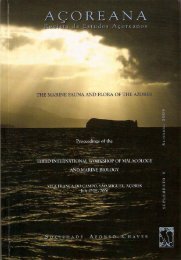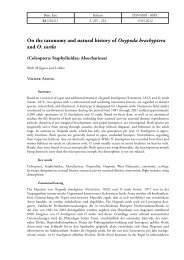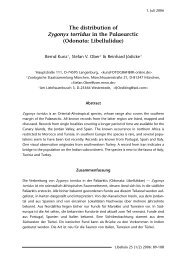A new species of Josephiella (Hymenoptera: Agaonidae) forming leaf
A new species of Josephiella (Hymenoptera: Agaonidae) forming leaf
A new species of Josephiella (Hymenoptera: Agaonidae) forming leaf
You also want an ePaper? Increase the reach of your titles
YUMPU automatically turns print PDFs into web optimized ePapers that Google loves.
JOURNAL OF NATURAL HISTORY, 2001, 35, 33-40<br />
A <strong>new</strong> <strong>species</strong> <strong>of</strong> <strong>Josephiella</strong> (<strong>Hymenoptera</strong>: <strong>Agaonidae</strong>) <strong>forming</strong> <strong>leaf</strong><br />
galls on Ficus microcarpa L. (Moraceae)<br />
JOHN W. BEARDSLEY' and JEAN-YVES RASPLUS*<br />
INRA, Laboratoire de Modélisation et Biologie Evolutive, 488 rue Croix<br />
de Lavit, F-34090 Montpellier, Frunce<br />
(Accepted 30 November 1999)<br />
A second <strong>species</strong> <strong>of</strong> <strong>Josephiella</strong> Narendran, J. microcarpae, is described and<br />
figured, based on specimens reared in Hawaii, California and the Canary Islands.<br />
This wasp develops in galls on the leaves <strong>of</strong> Ficus microcarpa L., a widely<br />
cultivated ornamental banyan tree that is native to South-East Asia and adjacent<br />
islands. It has not been found on any other hosts. Both sexes are described, and<br />
males, which are apparently al1 fully winged, are relatively rare. We postulate<br />
that this wasp is a recent introduction into Hawaii, California and the Canary<br />
Islands, from an unknown location in South-East Asia, where Ficus microcarpa<br />
is native.<br />
KEYWORDS: <strong>Agaonidae</strong>, Epichrysomallinae, <strong>Josephiella</strong>, <strong>new</strong> <strong>species</strong>, pest, Ficus,<br />
Moraceae.<br />
Introduc tion<br />
In May 1989, the first author noticed for the first time the presence <strong>of</strong> small,<br />
pustule-like galls on the leaves <strong>of</strong> a common ornamental Ficw tree, F. microcarpa<br />
L. (figure 1) on the campus <strong>of</strong> the University <strong>of</strong> Hawaii in Honolulu. Specimens <strong>of</strong><br />
an Epichrysomallinae agaonid wasp that emerged from galled leaves held in the<br />
laboratory were identified as possibly a <strong>species</strong> <strong>of</strong> Carnarothorax by E. Grissell at<br />
the US National Museum in Washington, DC (Beardsley, 1992). Specimens were<br />
sent also to Z. BouEek at the Natural History Museum in London. Boutek (1997:<br />
119) referred briefly to the <strong>species</strong> stating '...one <strong>species</strong> <strong>of</strong> Acophilci Ishii<br />
(Epichrysomallinae), found recently in Hawaii, is believed to produce galls on the<br />
leaves <strong>of</strong> a Ficw'. In September 1997, the same wasp was discovered <strong>forming</strong> <strong>leaf</strong><br />
galls on F. microcarpa at Santa Ana, California by J. N. Nisson (Anon., 1998). In<br />
October 1997, the <strong>species</strong> had spread as far as the Canary Islands (Spain), where it<br />
was found causing heavy infestation on foliage <strong>of</strong> cultivated F. microcnrpa in Tenerife<br />
'Present address: 1026 Oak Dale Lane. Arcadia, CA 91006, USA.<br />
*lo whom corresporideiice is addrcsscd; email: raspius~ensani.inra.fr.<br />
Journal o/ Nutiirul History<br />
ISSN 0022-2933 print/ISSN 1464-5262 online 0 2001 Taylor & Francis Ltd<br />
http://www. tandf.co.uk/journals
. <<br />
A <strong>new</strong> <strong>species</strong> <strong>of</strong> <strong>Josephiella</strong> 35<br />
. .<br />
. . .<br />
line. Antennal formula 1 l( 1)53 (the annellus hardly visible in J. microcarpae). Scape<br />
short not reaching the median ocellus. Occipital carina absent (in dried specimens<br />
<strong>of</strong> J. microcarpae, the occiput may be partly collapsed and a consequent crease<br />
misinterpreted as a carina). Axillar grooves shallow or obliterated. Tarsi foursegmented.<br />
Stigmal vein longer than marginal vein. Stigmal vein at an angle <strong>of</strong><br />
about 90". Marginal fnnge present.<br />
<strong>Josephiella</strong> clearly dif€ers from Acophila in having four-segmented tarsi (vs fivesegmented),<br />
bilobed clypeus (vs truncate). Antennae inserted above the ocular line<br />
(vs inserted below the ocular he). Occipital carina absent (vs clearly visible).<br />
Scutellum without distinct punctures (vs with punctures). Marginal vein about as<br />
long as the sti,gnal (vs marginal clearly longer than the stigmal). Sti,gnal vein at an<br />
angle <strong>of</strong> about 90" (vs stigmal vein at an angle less than 900). Marginal fringe<br />
present (vs absent).<br />
The closest genus to <strong>Josephiella</strong> is Odont<strong>of</strong>roggatia Ishii. In the key to genera <strong>of</strong><br />
Nearctic <strong>Agaonidae</strong> (BouCek, 1997), couplet lO(8) should be altered as follows to<br />
allow identification <strong>of</strong> these genera:<br />
lO(8)<br />
Stigmal vein at a right angle to wing margin and about as long as marginal vein,<br />
the postmarginal vein very short and stub-like; body brown to yellow, shiny;<br />
tarsi 4-segmented . . . . . . . . . EPICHRYSOMALLINAE, 10'<br />
- Stigmal vein more or less at an acute angle to wing margin and shorter, etc. . 11<br />
lo'( 10) Fernale: head transverse. Antennal formula 1163, scape long, reaching the median<br />
ocellus. Supraclypeal afea not delimited. Scutellum bearing 2 x 2 setae. Avillar<br />
grooves well marked. Male: mandible long and falcate. Petiole apparent, some-<br />
-<br />
times with a ventral hook or lateral teeth . . . . . . Odont<strong>of</strong>roggatia Ishii<br />
Female: head subglobose (figure 3C). Antennal area formula 11 (1)53 (figure 2A),<br />
the annellus hardly visible in J. microcarpae; scape short, not reaching the median<br />
ocellus. Supraclypeal area well delimited, subquadrate (figure 2B). Scutellum<br />
bearing at least 2 x 3 setae. Axillar grooves shallow or obliterated (figure 2D).<br />
Male: mandible normal. Petiole short . . . . . . <strong>Josephiella</strong> Narendran<br />
In the key to the Oriental genera <strong>of</strong> Epichrysomallinae (Narendran and Sheela,<br />
1996), the <strong>new</strong> <strong>species</strong> described here will run to the genus <strong>Josephiella</strong> only with<br />
difficulty. In the first couplet <strong>of</strong> their key these authors refer to the relative widths<br />
<strong>of</strong> the anterior margin <strong>of</strong> the scutellum and posterior margin <strong>of</strong> the midlobe <strong>of</strong> the<br />
mesoscutum. In the <strong>new</strong> <strong>species</strong> described below, the sutures that define these sclerites<br />
are weakly developed, and not easily seen; they are well defined in the type <strong>species</strong>.<br />
However, in specimens <strong>of</strong> the <strong>new</strong> <strong>species</strong> in which the axillary sutures are discernible,<br />
they intersect the transscutal articulation close together near the midline, as in the<br />
type <strong>species</strong> <strong>of</strong> <strong>Josephiella</strong>. The <strong>species</strong> described here shares another important,<br />
apparently apomorphic character with the type <strong>species</strong> <strong>of</strong> <strong>Josephiella</strong>: the unusual<br />
habit <strong>of</strong> developing within <strong>leaf</strong> galls.<br />
<strong>Josephiella</strong> microcarpae, sp. n.<br />
(figures 2-4)<br />
Fernale (fgtae 4B). Length <strong>of</strong> holotype 2.2 mm. Body uniformly dark brown;<br />
antennae and legs, including coxae, mostly pale yellow, femora slightly darkened,<br />
pretarsi dark; wings hyaline, veins pale yellow-brown, semi-transparent; mouthparts<br />
pale. Body weakly sclerotized, gaster and mesosoma tending to collapse and shnvel
* +-<br />
P<br />
,<br />
A nzw <strong>species</strong> <strong>of</strong> <strong>Josephiella</strong> 37<br />
. .<br />
,.<br />
. -. .- '<br />
. .-<br />
...:... . .<br />
i<br />
. ... . . . .<br />
. ..<br />
FIG. 3.<br />
<strong>Josephiella</strong> miciocnrpae sp. n. female. (A-C) Head. (A) Dorsal; (B) frontal (antennae<br />
removed); (C) lateral; (D) dorsum <strong>of</strong> mesosorna and base <strong>of</strong> gaster.<br />
<strong>of</strong> anteriorly directed spiracular foveae. Hind coxae (figure 3D) with dorsal surfaces<br />
reticulate. Gaster smooth and shining.<br />
Setae <strong>of</strong> head and mesosoma sparse, distributed as in J. mnlnbnrensis, but<br />
apparently more eiongate, those <strong>of</strong> face averaging about 45-55 pm long<br />
(figure 3A-C). Longer setae <strong>of</strong> mesosoma mostly 60-75 pm long; sparsely scattered,<br />
and in a continuous row (ca 10) on posterior margin, on pronotum; less numerous<br />
on mesonotum. Mesonotum with one conspicuous pair <strong>of</strong> forward directed setae<br />
near posterior margin and three or four laterally on each side; axillae each with one<br />
such seta; scutellum with two pairs <strong>of</strong> elongate setae sublaterally, one near posterior<br />
margin and one near midlength; a few short inconspicuous short setae (12-15pm)<br />
prescnt on scutellum and axillae, particularly laterally. Gaster largely bare, with a<br />
few fine setae in transverse line on each tergite.<br />
Head globular, in dorsal view (figure 3A) wider than long (ca 7:4), ocelli in<br />
broadly obtuse trianzle, area between them slightly raised and flattened, distance
5 . *<br />
r<br />
-.<br />
.-<br />
. .<br />
...<br />
.<br />
.-..<br />
. .<br />
.-<br />
I .<br />
A <strong>new</strong> <strong>species</strong> <strong>of</strong> JosephieiIa 39<br />
Fore wing (figure 4A, B) hyaline, with venation very similar to J. malabarensis,<br />
marginal vein shorter than stigmal, postmarginal ca one-half as long as marginal;<br />
with ca six large setae on submarginal vein, two on marginal and one at apex <strong>of</strong><br />
postmarginal; marginal and postmarginal with several smaller setae; discal setae <strong>of</strong><br />
wing sparse, as in J. malabarensis, mostly small (ca 6pm, long) and somewhat<br />
spiniform; apical fringe setae short (ca 15-18 pm long), moderately dense.<br />
Legs similar to J. malabarensis; hind tibia (figure 2D) with a comb <strong>of</strong> five slightly<br />
curved spines on inner face near apex, a series <strong>of</strong> ca eight spines and several long<br />
setae on outer margin.<br />
Gaster globular, dorsally humped and nearly as long as head plus mesosoma<br />
combined when distended with ova, riearly sessile, the petiolar segment much broader<br />
than long (figure 3D), hypopygium not reaching apex.<br />
Male. Fully winged, similar to female in colour and form, except for slightly<br />
smaller average size (length <strong>of</strong> allotype 1.1 mm), and details as follows: Antenna<br />
(figure 2B) shorter (ca 480pm long) with three funicle segments plus very narrow<br />
anellus (as in female); club distinctly two-segmented, basic three-segmented condition<br />
indica ted by marginal constriction and sensory plates. Gaster less strongly developed,<br />
relatively flat, elongate-oval in dorsal outline, about as long as mesosoma; genitalia<br />
(figure 2E) well developed, with conspicuous digiti and digital spines.<br />
Holotype female and male aliotype. Hawaiian 1s.: Oahu 1.: Honolulu, University<br />
<strong>of</strong> Hawaii, nanoa, July 1994 (J. W. Beardsley) ex <strong>leaf</strong> galls on Ficus microcarpa.<br />
Paratype: Hawaiian 1s.: Kauai 1.: Alexander Dam, 2 February 1992 (A. Asquith),<br />
galls on Ficus leaves. Molokai 1.: Kualapuu in c<strong>of</strong>fee field, 30 September to<br />
14 October 1994, W. D. Perreira coll., blue sticky board trap (1 female); napulehu<br />
nr. Ililiopae Heiau, el. 60 ft, J. W. Beardsley and W. D. Perreira colls., sweeping<br />
(1 male); 22 July 1994, W. D. Perreira coll., reared ex leaves <strong>of</strong> Ficus microcarpa<br />
(3 females, 2 males); naunaloa, el. ca 1200 ft, 24 June to 8 July 1994, W. D. Perreira<br />
and M. Fukuda cok, yellow sticky board trap (2 females). Oahu 1.: Honolulu,<br />
U. H. Manoa Campus, el cn 60 ft, 30 May 1989, J. W. Beardsley coll., reared ex<br />
<strong>leaf</strong> galls on Fictcs microcarpa (30 females); samL - ___. 2s ;oic.rype and allotype<br />
(1 female, 2 males); Honolulu, U. H. Manoa, 28 June 1989, W. Nagamine coll., ex<br />
Fictis retiisn ( = E microcarpa) (4 females, USNM); Honolulu, McCully St. overpass,<br />
el. ca 60 ft, 8 October 1994, J. W. Beardsley coll., reared ex <strong>leaf</strong> galls on Ficus<br />
microcarpa (15 females); Konahuanui, el. 3100 ft, 14 February 1993, W. D. Perreira<br />
coll. (2 females).<br />
California: Orange County: Santa Ana, 3 October 1997, J. N. Nisson coll., reared<br />
from <strong>leaf</strong> galls on Fictis microcarpa (5 females); Orange, 12 November 1997,<br />
J. N. Nisson and B. Sanford colls., reared ex <strong>leaf</strong> galls on Fictis microcarpa (3 females,<br />
2 males).<br />
Canary Islands: Tenerife: 1997, IIE 23716, in galls on Ficus nitidn (=F.<br />
microcnrpa) (3 females).<br />
Holotype and allotype deposited in B. P. Bishop Museum, Honolulu, Hawaii.<br />
Paratypes in Bishop Museum and Hawaii Department <strong>of</strong> Agriculture, Honolulu, in<br />
California Department <strong>of</strong> Food and Agriculture, Sacramento; USNM Washington;<br />
National History Museum in London; INRA collection Montpellier.<br />
The <strong>new</strong> <strong>species</strong> can be easily separated from J. malnbnrensis Narendran by the<br />
very small annellus, hardly visible (vs well developed); the notauli obliterated (vs<br />
visible) and the gaster globular, not laterally compressed.<br />
Al1 rearings <strong>of</strong> these wasps in Hawaii yielded predominantly females, and in
















